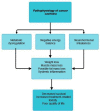Cancer Cachexia: New Insights and Future Directions
- PMID: 38067294
- PMCID: PMC10705516
- DOI: 10.3390/cancers15235590
Cancer Cachexia: New Insights and Future Directions
Abstract
Cancer remains a major health problem and is associated with cachexia in up to 80% of cases, leading to decreased survival and quality of life. Cachexia involves complex metabolic disturbances in both protein and energy balance, muscle wasting phenomena, weight loss, systemic inflammation, overall decreased performance status, and tolerability to treatment. The clinical impact of cancer cachexia is very complex, with early detection of cachectic patients and identification of predictive biomarkers being two key factors for improving survival. Thus, a better understanding of the complexity of cancer cachexia phenomena and its main pathophysiological mechanism is much needed. Our review highlights the most important information about cancer cachexia, aiming to disseminate updated research findings about this highly deadly condition.
Keywords: CT-imaging; biomarkers; cachexia; cancer; clinical impact; inflammation; pathophysiology; sarcopenia.
Conflict of interest statement
The authors have no conflict of interest to declare.
Figures





References
-
- Hariyanto T.I., Kurniawan A. Cachexia in Cancer Patients: Systematic Literature Review. Asian J. Oncol. 2020;06:107–115. doi: 10.1055/s-0040-1713701. - DOI
Publication types
LinkOut - more resources
Full Text Sources

